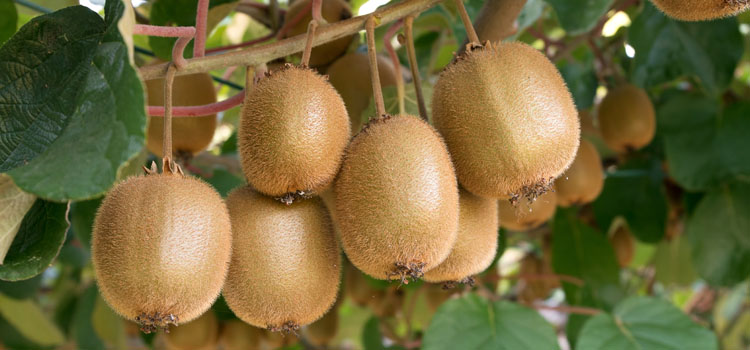Kiwi is cultivated for its healthy fruit. China is the birthplace of kiwi fruit, but New Zealand is currently the largest fruit producer. Vitamin C is found in a generous quantity in it. Apart from this, potassium, vitamin E, sodium, fibre, copper and antioxidants are also found in it. Therefore, it also increases the immunity of the body, which is also more beneficial for many types of diseases.
The upper part of the kiwi fruit is hairy and golden shiny, which is very attractive to look at. The demand for Kiwi fruit is very high in the market, and its price is also high. Because of this, the farmer brothers prefer to cultivate Kiwi more. If you are also planning to cultivate Kiwi, then in this article, you are given important information about how to grow Kiwi and which are the popular varieties of Kiwi.
Soil And Climate
For kiwi cultivation, land with proper drainage is required. More production can be obtained by cultivating Kiwi in light acidic and deep loamy soil, and the amount of organic matter in the ground should also be high. The pH value of the land should be between 5 to 6 in its cultivation.
Kiwi crop requires a temperate and mild subtropical climate. Average rain is suitable for the plants, and high temperature is not ideal for the yield. Kiwi plants germinate well at 15 degrees, and 5 to 7 degrees temperature is required for fruit development on the plants. Its plants can withstand a maximum temperature of 30 degrees.
Kiwi Land Preparation
Before cultivating Kiwi, destroy and remove the remains of the old crop grown in the field. After this, do deep ploughing of the field with Mahindra Arjun 605 or Mahindra 575. Apply water to the field after ploughing. After some time of watering, two to three slant ploughing of the field is done. After this, the land is levelled by putting a pad in the soil.
One metre wide and two feet deep pits are prepared in the flat land for kiwi plants. All these pits are prepared in rows. A distance of 4 metres is kept between each row and 5 to 7 metres between each pit. In the prepared holes, a sufficient amount of organic manure is mixed well with the soil and filled in the pits. After this, the pits are irrigated, and they should be covered. All these pits should be prepared two to three months before transplanting.
Kiwi Fertiliser Needs
Kiwi plants are planted in the prepared pits in the field. It is necessary to give these pits a proper amount of organic and chemical fertilisers. This allows the plants to grow correctly. To provide the quantity of manure, 50 GM NPK with 20 KG old cow dung. Mix the quantity well with the soil and fill it in the pits. After this, the plants are planted in these pits. Later, this amount of manure has to be given for the first two years, and along with the development of the plant, the amount of waste is increased. After giving fertiliser in the field, irrigate the plants immediately.
Kiwi Plants Irrigation
Water has to be given special attention in the cultivation of Kiwi. Its initial irrigation is done just after transplanting. In the summer season, it is necessary to water the plants for three to four days; in the winter, water the plants at an interval of 8 to 10 days. In the rainy season, water should be given when needed. Its plants require 18 to 20 irrigations in a year.
Weed Control
Special attention should also be paid to weed control in Kiwi crops. Natural method weeding - hoeing is used for weed control. The first weeding in its yield is done 20 to 25 days after transplanting. After this, the plants are hoed every month. Due to this, the plants develop well. After the rainy season, the vacant land is ploughed with a plough, and the weeds in the field are destroyed.
Yield Benefits
More than 400 plants can be planted in one hectare of Kiwi field. From one plant, 90 to 100 kg of fruits are produced. According to this, a 40,000 to 50,000 KG yield is obtained from the plants planted in one hectare of field. The market price of Kiwi is Rs 100 to 250 per kg, so farmers can earn up to 20 lakhs annually from its one-time harvesting.
Kiwi Fruit Harvesting
It takes more than 4 years for the kiwi crop to be ready. When the flowers start blooming on their plants, after 8 to 9 months, the fruits are prepared for ripening. During that time, the fruits are harvested. After ripening, the kiwi fruit appears soft and very attractive golden. The fruits are harvested and stored in a shady place and sent to be sold in the market. Its fruits can be used to eat for more than three to four weeks.
Hope found this article helpful, and to read more such farming content, stay tuned with us.





